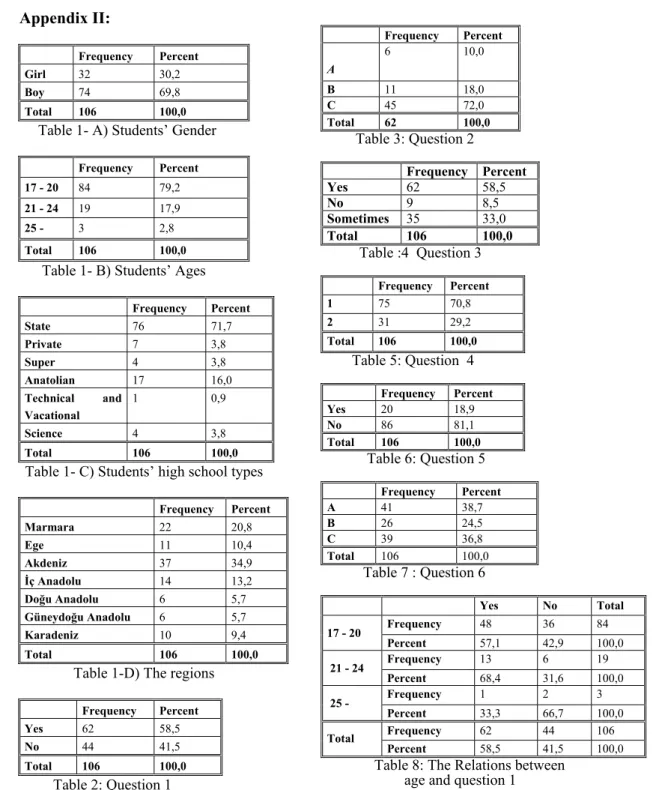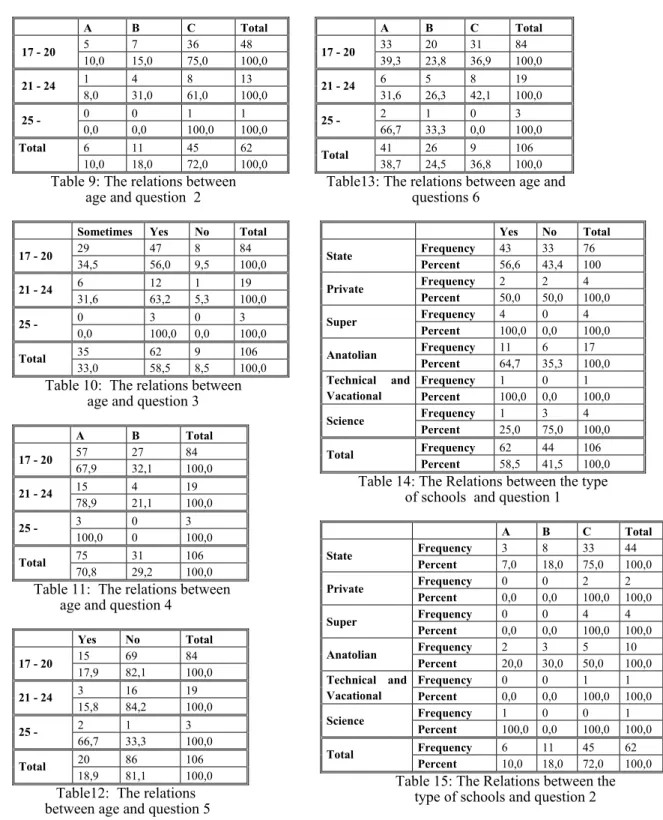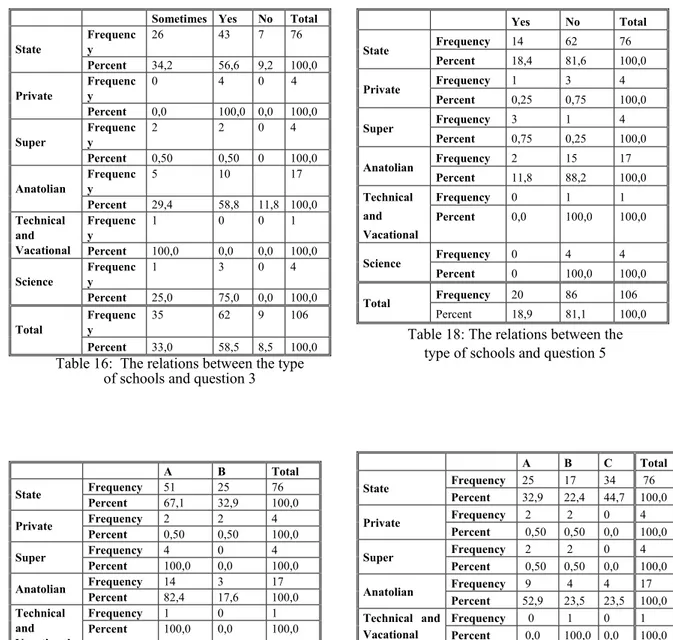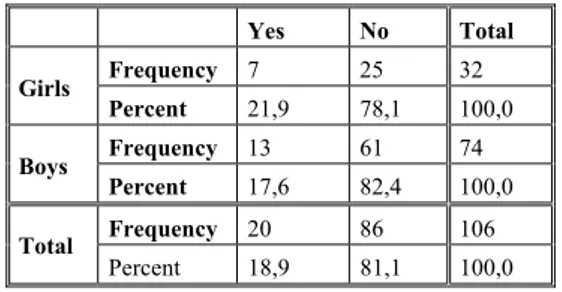CULTURAL PROBLEMS OF TURKISH
STUDENTS WHILE LEARNING ENGLISH AS A
FOREIGN LANGUAGE
Binnur Genç İlter
Cem Oktay Güzeller
Abstract
Teaching a foreign language by means of culture has become increasingly widespread nowadays. As an English teacher, we should try to keep students interested in the classroom. Culture is one of the best ways of motivation and it also provides students with useful models of authentic use of the language in the classroom. On the other hand, cultural differences may bring some problems into the classrooms while learning a foreign language.
This article has attempted to help teachers understand and solve their students’ cultural problems in the classroom. It also aims at examining the students’ ideas about the cultural differences.
Keywords: Culture, cultural values, ELT, cultural problems İNGİLİZCEYİ YABANCI DİL OLARAK ÖĞRENEN
TÜRK ÖĞRENCİLERİN KARŞILAŞTIKLARI KÜLTÜREL SORUNLAR Özet
Son zamanlarda yabancı bir dili kültürle birlikte öğretmek giderek yaygınlaşmaya başladı. İngilizce öğretmeni olarak bizler sınıfta öğrencilerin ilgisini sürekli kılmağa çalışmalıyız. Kültür öğrenciyi güdülemenin en iyi yollarından biridir,öğrencilerin dili daha iyi algılayabilmeleri için otantik ortamlar oluşturur. Yabancı bir dili öğrenirken ortaya çıkan kültürel faklılıklar da bazı sorunlara neden olabilir.
Bu makalede Türk öğrencilerinin karşılaştıkları sorunlar ele alınmakta ve öğretmenlere bu sorunların aşılması için bazı önerilerde bulunulmaktadır.
Anahtar sözcükler: Kültür, kültürel değerler, İngilizce öğretimi, kültürel problemler
1. Introduction
It is a fact that the term ‘culture’ contains beliefs, ideas, values and knowledge. According to Adaskou et al 1990, culture is composed of literature, music, fine arts, films and plays. Culture also shows the life style in the target community.
Culture and teaching language cannot be separated, thus culture must be taught while teaching a target language. If languages are taught without their cultures, students are only the strangers who aren’t familiar with the target languages. It is important to mention that cultural elements of the target language should be taught carefully.
Widdowson 1990 claims that a child acquires the semantic and syntactic systems together with his cultural knowledge, on the other hand, while learning a foreign language the student tends to acquire the language code of another community. The idea that a child acquires his native language together with its culture indicates that language can not be taught without cultural background.
Ellis 1990 states that students who are interested in the social and cultural life of the native country can learn a foreign language better than the other students, therefore students should be given support which will enable them to acquire the necessary cultural knowledge.
Jiang 2000 implies that it is impossible to teach the target language without teaching the target culture. The students can be exposed to an empty frame of language if they don’t learn cultural aspects of the target country.
According to Chastain 1988 teaching culture in EFL classrooms has got a crucial role of the course. It is a well-known fact that language teaching and culture are bound and during international communications students require social and cultural awareness.
2. Importance of the study
Teaching culture in EFL classrooms makes communication successful for the students who want to learn the target language in natural ways.
The use of target culture elements in EFL classrooms encourages the students to learn English effectively. This paper shows the relationship between culture and language learning.
3. Purpose of the study
This study aims at researching arguments of culture, teaching culture and cultural problems of Turkish students while learning English. The purpose of this article is also to give an idea about the problems based on cultural differences in the classroom.
4. Problem of the study
In this study, the following research questions were treated:
1. How can we select the proper cultural materials for our students?
2. What is the attitude of Turkish students towards the cultural elements of EFL lessons?
3. What do the students need as cultural elements in EFL classrooms? 5. Method of the study
In this research paper a survey was designed to understand the students’ point of view about language and culture. The survey was divided into two sections (Appendix 1). The first section was about the personal information of the students and the second section was about the attitude of the students towards the cultural elements of textbooks in EFL classrooms. The questionnaire was completed by 150 preparatory class students at Akdeniz University in Antalya. At Akdeniz University, the students are required to learn English and reach upper intermediate level by the end of the year. The questionnaire was administered to the students with the help of their teachers. The data analysis was completed but they didn’t aim at carrying out in depth statistical evolution of data.
6. Limitations of the study
This study is limited to Akdeniz University which provides one year preparatory class education. This study is also limited to 150 students of all the departments. 7. Findings
7.1 Findings based on the students’ general information
• 79.2% of the students were between the ages of 17-21; 17.9% of them were between 21-24 and 2.8% of them were 25 or over it.
• 30.2% of the students were girls and 69.9% of the students were boys.
• In the research, 71.7% of the students were from state high schools, 16% from Anatolian high schools, 3.8% from super high schools, and 3.8% from private high schools. 3.8% of them were from science high schools, only 0.9% of them from technical high schools.
• The students were from seven different regions all over Turkey.
• 20.8% of the respondents were from Marmara, 10.4% from Ege, 34.9% from Akdeniz, 13.2% from Middle Anatolia, 5.7% from East Anatolia, 5.7% from
South - East Anatolia and 9.4 % of them were from Karadeniz regions (Appendix 2).
7.2 Findings based on the students’ ideas about culture
• 62% of them stated that they wanted to learn the culture of the target lan- guage they are learning.
• 41, 5% of the students said that they wanted to learn cultural elements of the target language only from reading passages.
• 10.4% of them stated that they wanted to learn it just like their cultural val- ues.
• 42.5% of them declared that they wanted to learn it in order to understand the target language better.
• 58.5% of the students implied that they didn’t like and understand the cul- tural words which belong to the target language.
• 70.8 % of the students mentioned that learning different cultures provided them with different point of view about the world in which they lived.
• 29.2% of them indicated that different cultural values developed their critical thought.
• 81.1% of the students stated that they would not lose their national identity while learning cultural values that belong to another country.
• 38.7% of the students thought that the course books are aimed at teaching En- glish culture completely.
• 24.5% of them stated that English course books didn’t give importance to Turkish culture.
• 36.8% of them thought that publishers only wanted to teach cultures of the countries where English was spoken.
• All the students over 25 explained that unknown words belonging to the target language’s culture bothered them. It shows that the older the students are less tolerant about different cultures.
• 78.9% of the students between 21 - 24 and all the students over 25 claimed that learning different cultures provided them with an idea of comparison between their culture and the other culture.
• According to the results, the students from super high schools and technical high schools wanted to learn British/American culture more than those of Anatolian, state, private and science high schools.
• All the students from super high schools and technical high schools mentioned that they could get a different view about the world by comparing their culture with target language’s culture.
• 75% of the students from science schools stated that they wanted to learn the culture in order to understand the target language.
• If we have a look at the gender, it can be seen that girls with the ratio 68.8% wanted to learn British/American culture more than the boys.
• The majority of the boys and girls wanted to learn the target language’s cul-ture in order to understand the language better
• 59.4% of the girls mentioned that the unknown cultural words bothered them. • 68.8% of the girls wanted to learn British/American culture whereas 54.1% of the boys wanted to learn these cultures. It shows that girls are more eager to
learn different cultures than boys.
• 71.6% of the boys explained that different cultures would provide them to gain various thoughts about the world.
• 21. 9% of them mentioned that the course books didn’t give importance to Turkish people.
• 37.8% of the boys thought that publishers tried to teach only their culture. 8. Conclusion and suggestion
In conclusion, it can be inferred that the students from different high schools in Turkey have a tendency of learning different cultures by learning the target language. However, they believe that the course books used in EFL classrooms aim at teaching only the target language’s culture. The result appears to be very important because it shows that the students wanted to see some cultural values of Turkish people in their course books. Turkish students are conscious enough of the language teaching methods and they know that culture and language learning cannot be separated. Hence, English cannot be taught without British/American culture. The problem is how to select the correct cultural context. The context used in EFL classrooms should be familiar with the students.
It can be suggested that instead of teaching culture of the target language completely, it is more useful to take a cross - cultural approach to English language teaching. By focusing the cross - cultural values, the students will become more conscious to the world’s cultural beliefs. It is clear that the students will show tolerance to the universe which they live in when they learn different values of various countries.
References
Adeskou, K., D. Britten and B. Fashi 1990. Design Decisions on the Cultural Content of a Secondary English Course for Morocco. ELT Journal, 44/1:3-10
Chastain, K. 1988. Developing Second - Language Skills. Theory and Practice. Harcourt Brace Javanov inch: The USA
Ellis, R. 1990. Understanding Second Language Acquisition. OUP: Oxford
Jiang, W. 2000. The Relationship between Culture and Language. ELT Journal 54 / 4: 328-334 Widdowson, H. G. 1990. Aspect of Language Teaching. Oxford: OUP
A P P E N D I C E S Appendix I
Part I
General Information
1. Your Age: ... 2. Your Gender: ... 3. Your School Type:………...
4. Where did you finish your high school ? ...
Part II
Students’ Ideas About Target Languages’ Culture
1. While learning English , Do you want to learn English / American culture ? a) Yes b) No c) Sometimes
2. If you want to learn English / American culture , how do you want to learn it ? a) Only in the reading passages about the target culture.
b) Just like my own cultural values.
c) A little bit to understand the target language.
3. Do the words which you don’t understand about target language’s culture bother you ?
a) Yes b) No c) Sometimes
4. What kind of contribitutions will you get by learning different cultural values ? a) It gives us different point of view abut the world we live in and life
b) It develops my critical thoughts.
5. While learning different culture, do you think you will lose your national identity ?
a) Yes b) No c) Sometimes
6. What kind of cultural problems do you usually face while learning a foreign language ?
a) British - American coursebooks wanted to teach only their culture b) They don’t give importance to Turkish culture
Appendix II:
Frequency Percent Girl 32 30,2
Boy 74 69,8
Total 106 100,0
Table 1- A) Students’ Gender
Frequency Percent 17 - 20 84 79,2
21 - 24 19 17,9
25 - 3 2,8
Total 106 100,0
Table 1- B) Students’ Ages
Frequency Percent State 76 71,7 Private 7 3,8 Super 4 3,8 Anatolian 17 16,0 Technical and Vacational 1 0,9 Science 4 3,8 Total 106 100,0
Table 1- C) Students’ high school types
Frequency Percent Marmara 22 20,8 Ege 11 10,4 Akdeniz 37 34,9 İç Anadolu 14 13,2 Doğu Anadolu 6 5,7 Güneydoğu Anadolu 6 5,7 Karadeniz 10 9,4 Total 106 100,0
Table 1-D) The regions
Frequency Percent Yes 62 58,5 No 44 41,5 Total 106 100,0 Table 2: Question 1 Frequency Percent A 6 10,0 B 11 18,0 C 45 72,0 Total 62 100,0 Table 3: Question 2 Frequency Percent Yes 62 58,5 No 9 8,5 Sometimes 35 33,0 Total 106 100,0 Table :4 Question 3 Frequency Percent 1 75 70,8 2 31 29,2 Total 106 100,0 Table 5: Question 4 Frequency Percent Yes 20 18,9 No 86 81,1 Total 106 100,0 Table 6: Question 5 Frequency Percent A 41 38,7 B 26 24,5 C 39 36,8 Total 106 100,0 Table 7 : Question 6 Yes No Total Frequency 48 36 84 17 - 20 Percent 57,1 42,9 100,0 Frequency 13 6 19 21 - 24 Percent 68,4 31,6 100,0 Frequency 1 2 3 25 - Percent 33,3 66,7 100,0 Frequency 62 44 106 Total Percent 58,5 41,5 100,0
Table 8: The Relations between age and question 1
A B C Total 5 7 36 48 17 - 20 10,0 15,0 75,0 100,0 1 4 8 13 21 - 24 8,0 31,0 61,0 100,0 0 0 1 1 25 - 0,0 0,0 100,0 100,0 6 11 45 62 Total 10,0 18,0 72,0 100,0
Table 9: The relations between age and question 2
Sometimes Yes No Total
29 47 8 84 17 - 20 34,5 56,0 9,5 100,0 6 12 1 19 21 - 24 31,6 63,2 5,3 100,0 0 3 0 3 25 - 0,0 100,0 0,0 100,0 35 62 9 106 Total 33,0 58,5 8,5 100,0
Table 10: The relations between age and question 3
A B Total 57 27 84 17 - 20 67,9 32,1 100,0 15 4 19 21 - 24 78,9 21,1 100,0 3 0 3 25 - 100,0 0 100,0 75 31 106 Total 70,8 29,2 100,0
Table 11: The relations between age and question 4
Yes No Total 15 69 84 17 - 20 17,9 82,1 100,0 3 16 19 21 - 24 15,8 84,2 100,0 2 1 3 25 - 66,7 33,3 100,0 20 86 106 Total 18,9 81,1 100,0
Table12: The relations between age and question 5
A B C Total 33 20 31 84 17 - 20 39,3 23,8 36,9 100,0 6 5 8 19 21 - 24 31,6 26,3 42,1 100,0 2 1 0 3 25 - 66,7 33,3 0,0 100,0 41 26 9 106 Total 38,7 24,5 36,8 100,0
Table13: The relations between age and questions 6 Yes No Total Frequency 43 33 76 State Percent 56,6 43,4 100 Frequency 2 2 4 Private Percent 50,0 50,0 100,0 Frequency 4 0 4 Super Percent 100,0 0,0 100,0 Frequency 11 6 17 Anatolian Percent 64,7 35,3 100,0 Frequency 1 0 1 Technical and Vacational Percent 100,0 0,0 100,0 Frequency 1 3 4 Science Percent 25,0 75,0 100,0 Frequency 62 44 106 Total Percent 58,5 41,5 100,0
Table 14: The Relations between the type of schools and question 1
A B C Total Frequency 3 8 33 44 State Percent 7,0 18,0 75,0 100,0 Frequency 0 0 2 2 Private Percent 0,0 0,0 100,0 100,0 Frequency 0 0 4 4 Super Percent 0,0 0,0 100,0 100,0 Frequency 2 3 5 10 Anatolian Percent 20,0 30,0 50,0 100,0 Frequency 0 0 1 1 Technical and Vacational Percent 0,0 0,0 100,0 100,0 Frequency 1 0 0 1 Science Percent 100,0 0,0 100,0 100,0 Frequency 6 11 45 62 Total Percent 10,0 18,0 72,0 100,0
Table 15: The Relations between the type of schools and question 2
Sometimes Yes No Total Frequenc y 26 43 7 76 State Percent 34,2 56,6 9,2 100,0 Frequenc y 0 4 0 4 Private Percent 0,0 100,0 0,0 100,0 Frequenc y 2 2 0 4 Super Percent 0,50 0,50 0 100,0 Frequenc y 5 10 17 Anatolian Percent 29,4 58,8 11,8 100,0 Frequenc y 1 0 0 1 Technical and Vacational Percent 100,0 0,0 0,0 100,0 Frequenc y 1 3 0 4 Science Percent 25,0 75,0 0,0 100,0 Frequenc y 35 62 9 106 Total Percent 33,0 58,5 8,5 100,0
Table 16: The relations between the type of schools and question 3
A B Total Frequency 51 25 76 State Percent 67,1 32,9 100,0 Frequency 2 2 4 Private Percent 0,50 0,50 100,0 Frequency 4 0 4 Super Percent 100,0 0,0 100,0 Frequency 14 3 17 Anatolian Percent 82,4 17,6 100,0 Frequency 1 0 1 Technical and Vacational Percent 100,0 0,0 100,0 Frequency 3 1 4 Science Percent 75,0 25,0 100,0 Frequency 75 31 106 Total Percent 70,8 29,2 100,0
Table 17: The relations between the type of schools and question 4
Yes No Total Frequency 14 62 76 State Percent 18,4 81,6 100,0 Frequency 1 3 4 Private Percent 0,25 0,75 100,0 Frequency 3 1 4 Super Percent 0,75 0,25 100,0 Frequency 2 15 17 Anatolian Percent 11,8 88,2 100,0 Frequency 0 1 1 Technical and Vacational Percent 0,0 100,0 100,0 Frequency 0 4 4 Science Percent 0 100,0 100,0 Frequency 20 86 106 Total Percent 18,9 81,1 100,0
Table 18: The relations between the type of schools and question 5
A B C Total Frequency 25 17 34 76 State Percent 32,9 22,4 44,7 100,0 Frequency 2 2 0 4 Private Percent 0,50 0,50 0,0 100,0 Frequency 2 2 0 4 Super Percent 0,50 0,50 0,0 100,0 Frequency 9 4 4 17 Anatolian Percent 52,9 23,5 23,5 100,0 Frequency 0 1 0 1 Technical and Vacational Percent 0,0 100,0 0,0 100,0 Frequency 3 0 1 4 Science Percent 75,0 0,0 0,25 100,0 Frequency 41 26 39 106 Total Percent 38,7 24,5 36,8 100,0
Table19: The relations between the type of schools and question 6
Yes No Total Frequency 22 10 32 Girls Percent 68,8 31,2 100,0 Frequency 40 34 74 Boys Percent 54,1 45,9 100,0 Frequency 62 44 106 Total Percent 58,5 41,5 100,0
Table 20: The relationship between the gender and question 1.
A B C Total Frequency 1 5 16 22 Girls Percent 0,05 0,23 0,72 100,0 Frequency 5 6 29 40 Boys Percent 0,72 0,13 0,15 100,0 Frequency 6 11 45 62 Total Percent 0,72 0,10 0,18 100,0
Table 21: The relationship between the gender and question 2
Sometimes Yes No Total Frequency 10 19 3 22 Girls Percent 31,3 59,4 9,4 100,0 Frequency 25 43 6 74 Boys Percent 33,8 58,1 8,1 100,0 Frequency 35 62 9 106 Total Percent 33,0 58,5 8,5 100,0
Table 22: The relationship between the gender and question 3
A B Total Frequency 22 10 32 Girls Percent 68,8 31,3 100,0 Frequency 53 21 74 Boys Percent 71,6 28,4 100,0 Frequency 75 31 106 Total Percent 70,8 29,2 100,0
Table 23: The relationship between the gender and question 4
Yes No Total Frequency 7 25 32 Girls Percent 21,9 78,1 100,0 Frequency 13 61 74 Boys Percent 17,6 82,4 100,0 Frequency 20 86 106 Total Percent 18,9 81,1 100,0
Table 24: The relationship between the gender and question 5
A B C Total Frequency 13 7 12 32 Girls Percent 40,6 21,9 37,5 100,0 Frequency 28 19 27 74 Boys Percent 73,1 25,7 36,5 100,0 Frequency 41 26 39 106 Total Percent 38,7 24,5 36,8 100,0
Table 25: The relationship between the gender and question 6



